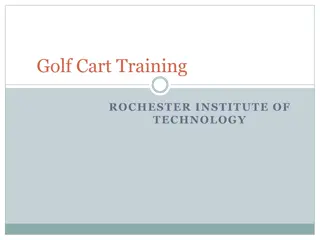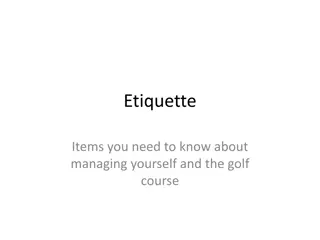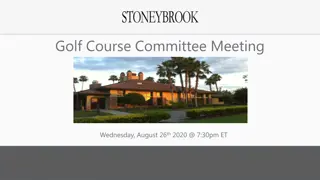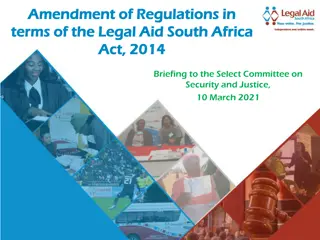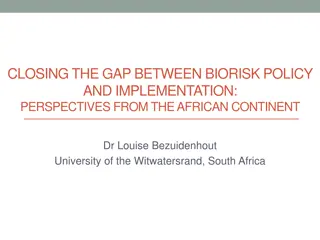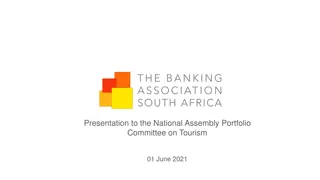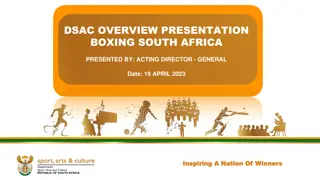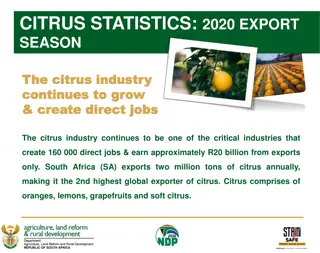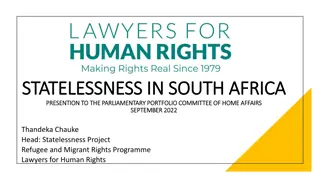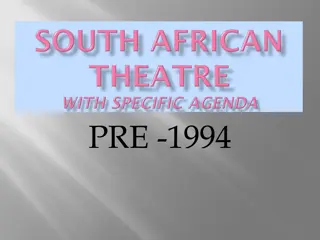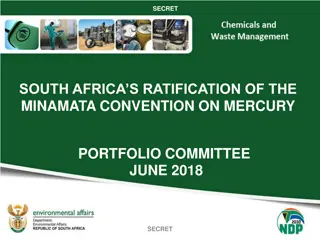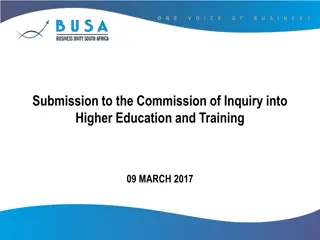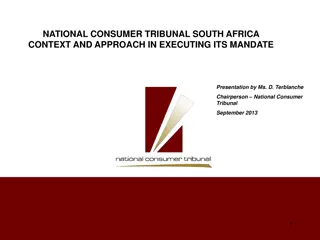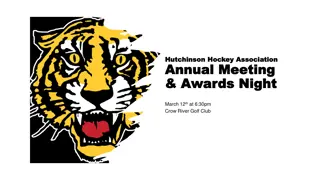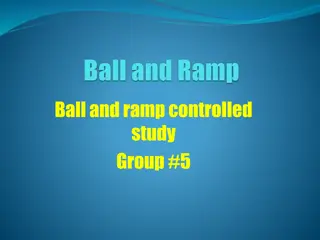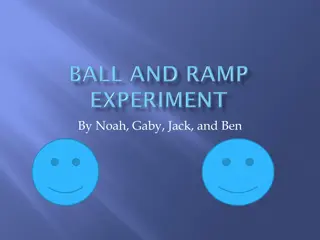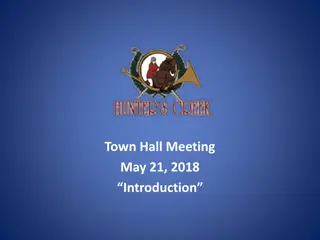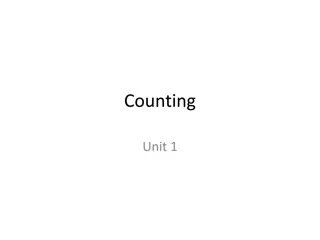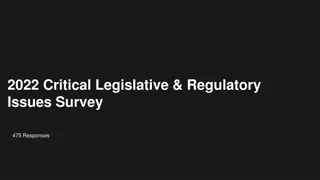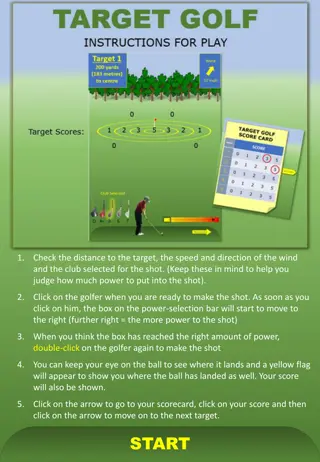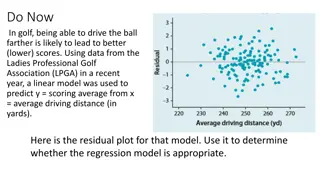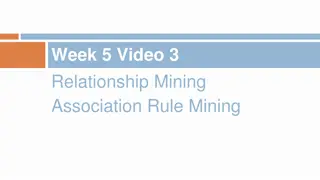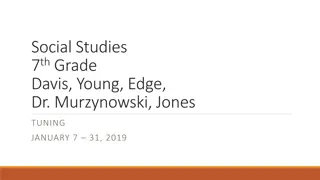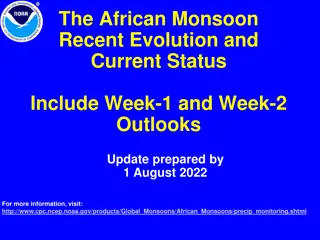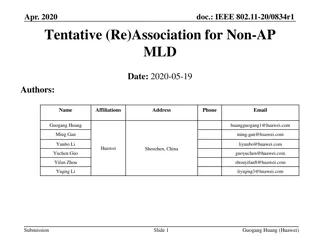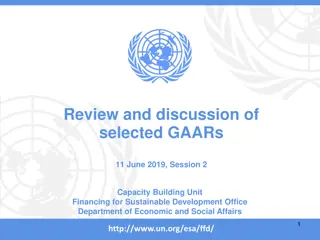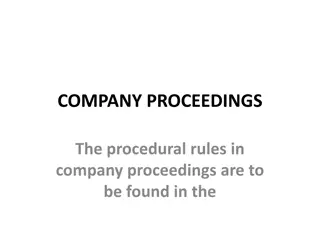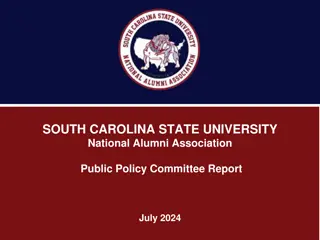Changes to Rules of Golf Croquet by South Africa Croquet Association
The South Africa Croquet Association introduced new rules in 2018, addressing various aspects such as swinging techniques, game starts, offside balls, scoring points, and more. The rules aim to clarify uncertainties and enhance the playing experience for both players and potential converts to the game. These changes include updates on outside agencies, game starts, declaration of strokes, scoring points, and offside balls. The association also provides guidance for players aspiring to become referees. Additionally, the letter published in the Croquet Gazette highlights concerns about certain practices in croquet, urging for more engaging gameplay.
Download Presentation

Please find below an Image/Link to download the presentation.
The content on the website is provided AS IS for your information and personal use only. It may not be sold, licensed, or shared on other websites without obtaining consent from the author. Download presentation by click this link. If you encounter any issues during the download, it is possible that the publisher has removed the file from their server.
E N D
Presentation Transcript
SOUTH AFRICA CROQUET ASSOCIATION THIS LETTER WAS PUBLISHED IN THE CROQUET GAZETTE A LITTLE WHILE AGO FROM ONE JOHN SOLOMAN! QUOTE: -I FEEL I MUST WRITE ON A SUBJECT THAT HAS CONCERNED ME FOR SOME TIME, THE PRACTICE OF SWINGING ( I BELIEVE IT IS ALSO CALLED CASTING) OVER ONE S BALL WHEN TAKING AIM. THIS IS SO DREADFULLY BORING TO WATCH THAT I SUSPECT THAT IT MUST PUT OFF POTENTIAL CONVERTS TO THE GAME. I HAVE ON OCCASIONS HAD TO RESTRAIN MYSELF, AFTER ABOUT THE TWENTIETH SWING FROM SHOUTING FOR GOD S SAKE HIT THE BLOODLY BALL ..
SOUTH AFRICA CROQUET ASSOCIATION VERSION 2018 CHANGES TO THE 2014 RULES OF GOLF CROQUET The new rules that were adopted by the South Africa Croquet Association meeting in 2018, have now been in operation for the past eighteen months and there is still some uncertainty about some of them. Hopefully we can cover most of the questions that have been put to the referees. If we could spend about one hour and a bit on the points we will go though now, it will be time well spent. We have a few keen players who would like to become referees and they may sit the one hour exam after this presentation followed by a half hour test on the court for a practical.
LISTED BELOW POINTS FOR DISCUSSION PARA 4 (4) OUTSIDE AGENCIES AND ACCESSORIES Scoring clips placed on a hoop are no longer an outside agency. Hitting them in a jump shot is therefore not a fault.(Rule 4.2) Clips left on the ground are, however an outside agency. (Rule 4.2.6) NOTE clips from a double banked game are an outside agency and should be removed. It should be noted that, as before, corner flags and half way markers must be placed outside of the court, not on the boundary line.(Rule 4.2) PARA 5 (5) THE START The winner of the toss starts with blue. If a fault is played within the first four strokes, the fault stands and the ball is in play. However, if the ball will impede the playing of another ball , it may be temporarily removed after its position has been marked. If it is discovered in the 5thball being played, the players have played the incorrect colours, the same colours will apply for the rest of the game. In a best of three games, the loser of the game just finished will start the next game, but the tournament manager may decide that the player who started the first game, plays second in the second game. (5.4.2)
POINTS FOR DISCUSSION PARA 6 (6) THE TURN A player may declare his stroke has been played without actually playing it (Rule 6.3.3 c) If a ball moves after 5 seconds it is to be replaced to the spot it was before moving (Rule 6.4.3) For example, the wind blows it. The Boundary is the inner edge of the line and any part of the ball that is over that is out (6.5.1(a)) A ball played and sitting on the boundary is out of play (Rule 6.5.1). An outside agency. PARA 7 (7) SCORING A POINT It should be noted that if the wrong hoop is contested and run before the game ends, the point is not scored (Rule 7.5.1) No points are scored since the last valid hoop. All balls are played from the penalty spot (Rule 7.5.5) In a timed game the clock is not stopped (Rule 7.5.3) Extra strokes used since the last correctly run hoop are restored (Rule 7.5.4) PARA 8 (10) OFFSIDE BALLS A ball is not offside if any contact was made with an opposition ball (Rule 8.3.3) The owner of the off side ball may ask if they must move to a penalty spot and which one.( NOTE MAY ASK) However, If a player plays an onside ball before a direction has been given about their offside ball, the onside ball can now be recalled.
POINTS FOR DISCUSSION PARA 9 (9) INTERFERENCE A ball may be stopped before it is clearly going out of play (Rule 9.1.2d) A player may lift a ball without permission to prevent interference.Rule 9,2,2(b)) If a ball hits an outside agency e. g. a ball from another game, the opponents may choose to leave the ball where it is OR guess the final resting position of that ball. The stroke is not replayed. (Rule 9.2.3a) If a moving ball is interfered with by an outside agency the stroke may be replayed (Rule 9.2.4a)
POINTS FOR DISCUSSION PARA 10 (11) THE WRONG BALL If a player or referee believes that a wrong ball is about to be played they must forestall play.(Rule 10.1.2) If a player or referee (on court) believes that a wrong ball has been played they must forestall play. (Rule 10.1.3) Accidental contact does not count (Rule 10.1.5) If the striker plays the partner ball or striker s partner played own ball, then the non- offending side may elect to a) Replace and replay (Rule 10.4.1) OR b) Ball Swap. Then the last stroke is treated as legal and all balls remain where they are except the position of the ball played is swapped with its partner ball and the swapped ball takes the offside status. (Rule 10.4.2) Non offending side plays next ball in sequence. If a ball is played which belongs to the opposition, and it is condoned by the opposition who then play their opposition ball, the game is restarted from the penalty spot. (Rule 10,5,2). If the same side plays two consecutive strokes (Rule 10,6) then A) No points scored B) Balls can be moved or left C) Non offending side chooses which ball to play
POINTS FOR DISCUSSION TYPES OF FAULTS. Rule 11,2 A fault is committed by a player who, during the striking period: Touches the mallet head with a hand. Strikes a ball as a result of kicking, hitting or throwing the mallet. Strikes a ball with any part of the mallet other than an end face of the head either deliberately or accidentally in a stroke which requires special care because of the proximity of a hoop or the peg or another ball. Strikes a ball with the mallet more than once in the same stroke or allows a ball to retouch the mallet. Maintains contact between the mallet and a ball. Causes a ball, while still in contact with the mallet, to touch a hoop, the peg, or unless the balls were in contact before the stroke, another ball. Strikes a ball when it lies in contact with a hoop upright or the peg other than away therefrom.
POINTS FOR DISCUSSION Types of faults continued. Touches any ball other than the ball they intended to strike with the mallet or any ball with any part of their body, clothes or personal property. Moves or shakes a stationary ball by hitting a hoop or the peg with the mallet or any part of the body, clothes or personal property. Causes damage to the court surface with the mallet that, before the court surface is repaired, is capable of significantly affecting a subsequent stroke played over the damaged area. PARA 11 (12 &13) FAULTS The penalty for faults is to leave the balls where they lie or replace them to the original place. Opponent s decision. Play is then continued by the non-offending side playing the next ball in sequence. (Rule 11.4.4) Accidentally touching a ball or moving ball by a non striking player, is no longer a penalty unless done so deliberately ???? Resting the arm on the ground or an outside agency is not a fault. No electronic or recording devices may be used to check strokes being played. (Rule 11,3,3)
POINTS FOR DISCUSSION PARA 12 OVERLAPPING PLAY If both players play at he same time the striker s stroke is the valid one. If both players play at the same time and the striker hits an invalid stroke, then the game is restarted at the penalty spot. (Rule 12.1.4) If the striker s ball is valid, replace the ball or balls moved by the offending strike and that turn is deemed to have been played. If both players of the same side strike at the same time, the opponents can choose to leave all balls where they ended up or replaced to where they were. Play resumes by the non offending side choosing either ball to play next. (Rule 12.2)
POINTS FOR DISCUSSION PARA 13 PLAYING AFTER PLAY HAS BEEN FORESTALLED If a player plays a stroke after the opposing side calls for forestalling of the stroke, the stroke is to be replayed. PARA 14 INFORMATION, ADVICE AND USE OF MARKERS Acting on misinformation may result in the stroke being replayed (Rule 14.1.2) PARA 15 REFEREEING A referee off court may intervene in a match if the rules are not complied with. If a fault is likely then the player should request it to be watched. If the request is not made the opponent may forestall and request watching. Para 16. BEHAVIOUR Note here that although a stroke must be played within one minute of the end of the previous stroke, it does not mean a player may take a minute each time a stroke is played. (Rule 16.3.1) PARA 17. DOUBLE BANKED GAMES It should be noted that in double banked games, the player first to reach a jointly contested hoop has priority over the other game. Not primary colours having right of way. PARA 18. PENALTY AREAS AND PENALTY AREA CONTINUATION The ball sent to penalty may be placed within a radius of one yard from the penalty spot.(Rule 18.1) Penalty area continuation. Winner of the toss goes first. The loser of the toss chooses which penalty spot to play from. Rule 7.5.5 (running a hoop out of order) Rule 10.5.4 (playing two or more consecutive opposition balls) Rule 12.1.4 (Invalid stroke when both sides play simultaneously)
POINTS FOR DISCUSSION PARA 19 HANDICAP PLAY Free shots are no longer called free shots or bisques. They are extra strokes In doubles where half the aggregate handicaps in both instances are x1/2, then one is rounded down and the other round up. (Rule 19.3.6) After incorrect information, an extra stroke is restored if it is cancelled under rule 14.1.2 (Rule 19.9) THANK YOU FOR YOUR ATTENANCE. ANY FURTHER QUESTIONS?


